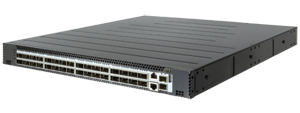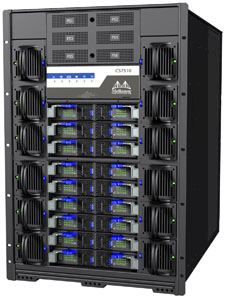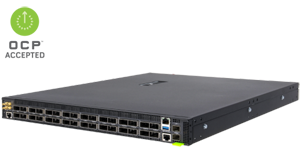Edgecore AS7726-32X 32-Port 100GbE Bare Metal Switch with ONIE – Part ID: 7726-32X-O-AC-B-US
$8,580.00
32-Port 100G QSFP28 switch, ONIE software installer, Broadcom Trident III, Intel Xeon D Processor, dual AC PSUs port-to-power airflow, rack mount kit (front and back) included
Description
AS7726-32X 100GBE Data Center SwitchThe Edgecore AS7726-32X switch is a Top-of-Rack (TOR) or spine switch for high-performance data centers. In a compact 1RU form factor, the switch provides line-rate L2 and L3 switching across the 32 x QSFP28 ports, and each QSFP28 port can be configured as 2x50G, 4x25G, 1x40GbE or 4x10GbE by using DAC breakout cables. The AS7726-32X can be deployed as a TOR switch supporting 10/25/50 GbE to servers with 40/50/100 GbE uplinks, or as a spine switch supporting 40/50/100 GbE spine interconnects. This open network switch is loaded with the Open Network Install Environment (ONIE) which supports the installation of compatible Network Operating System software, including the open source options Open Network Linux and commercial NOS offerings.Key FeaturesCost-effective, bare-metal switch infrastructure for data center fabric. Deploy as Top-of-Rack switch supporting 10 or 25 GbE to servers, with 40 GbE, 50 GbE, or 100 GbE uplinks.Deploy as spine switch supporting 40 GbE, 50 GbE, or 100 GbE ToR and spine interconnects.32 x QSFP28 switch ports, each supporting 1 x 100 GbE or 1 x 40 GbE, or via breakout cables, 2 x 50 GbE or 4 x 25 GbE or 4 x 10 GbE.Layer 2 or Layer 3 forwarding of 6.4 Tbps (full duplex).Supports hot/cold aisle with port-to-power and power-to-port airflow SKUs.All ports on front; PSUs and fans accessible from rear.Hot-swappable, load-sharing, redundant AC or -48V DC PSUs.5+1 redundant, hot-swappable fan modules.Energy efficient.Hardware switch pre-loaded with Open Network Install Environment (ONIE) for automated loading of compatible open source and commercial NOS offerings.Compatible with Open Network Linux (ONL), the open-source, OCP reference NOS. AS7726-32X Datasheet AS7726-32X Quick Start Guide
Back to the top





